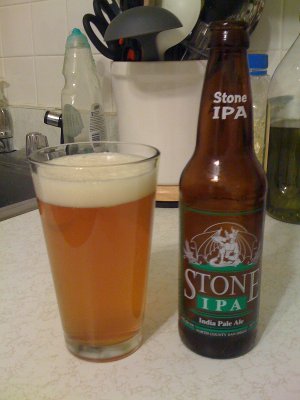As you may have noticed in my last review, I’ve got a number of reviews that have been sitting in the queue for a long time. I’ve been pretty good about keeping up with recent drinking, but I just haven’t gotten around to some of those older reviews, so I figured I’d just do a quick recap now…
- Leffe Blonde – I was surprised to see the relatively craptacular reviews on beer advocate (though apparently it’s gone up to a more respectable and appropriate B rating since I’ve last looked at it… the Bros still have it at a C). I wasn’t sure why the hate existed for this, then I found out that Leffe is owned by Inbev, the Belgian beer conglomerate that owns Anheuser-Busch and is famous for changing recipes for their acquired beers to save costs; even including long-standing Abbey breweries like Leffe which apparently now uses cheap adjuncts in their recipe (for all the beer nerd fury, I can’t really find much detail around this – though the brewery does say that it uses rice, which is not typically a favored ingredient in beer). In any case, it certainly looks, smells, and tastes fine. Sweet and bready, typical Belgian yeast aromas and taste. It’s not complex or subtle, but as a simple and straightforward brew, it’s pretty good. B (Beer Nerd Details: 6.6% ABV bottled (11.2 oz bottle) Drank from a goblet on 4/16/11.)
- Stone Double Bastard – It’s like Arrogant Bastard, only moreso. Very hoppy in the nose which follows through in the taste along with that unique blend of hoppy flavors that Stone uses for this brew. A nice bitterness and slick alcohol character are also present. It’s very good, but I don’t get the high praise heaped on it, though it does seem to have fallen off the BA top 100 at this point. B+ (Beer Nerd Details: 11.2% ABV bottled (22 oz bomber). Drank from a goblet on 4/23/11.)
- Trappist Achel 8° Bruin – This is the sixth of the seven Trappist breweries that I’ve sampled, though unfortunately, I was not particularly impressed with this brew (at least, compared with other dubbels). That’s not to say it was bad – definitely a nice appearance, with typical dark fruits and spiciness in the nose and taste. Relatively dry finish, drinkable, but not particularly complex either. I typically expect richer flavors out of a dubbel, though perhaps I should have this again just to make sure. Even considering that, it’s quite good. B+ (Beer Nerd Details: 8% ABV bottled (11.2 oz bottle) Drank from a goblet on 5/7/11.)
- Great Divide Yeti Imperial Stout – Another imperial stout that used to be in the BA top 100 but has since fallen out (no wonder I can never get a high percentage of completion on that list!) This one reminds me a lot of Victory’s Storm King Stout – very roasty, giving way to a hoppy bitterness as it warms up. Very well crafted, but not especially my style. B (Beer Nerd Details: 9.5% ABV bottled (12 oz bottle) Drank from a tulip on 5/7/11.)
- Ommegang Rare Vos – An old favorite of mine, I always worry about beers like this. Will it continue to live up to the expectations I’ve built up in my mind? I’ve spent the past year or two trying as many different, new beers as I could. Would this beer live up to memory? As it turns out, yes, it does. One of my first discoveries after Hennepin about a decade ago, I always come back to this one, a sweet and spicy Belgian amber. It is delicious and matches well with most meals. I daresay it’s a candidate for the vaunted A+, though I’ll just stick with an A for now. (Beer Nerd Details: 6.5% ABV bottled (750 ml caged and corked bottle) Drank from a tulip glass on 5/13/11.)
- Tröegs Pale Ale – Ok, so this is a relatively recent drink, but I don’t have a ton to say about it. It’s a decent, straightforward pale ale. It actually made a really nice first impression (nice hoppy presense of pine and grapefruit), but it loses some of its punch as it warms. Certainly not among the best pale ales, but well worth a try… B- (Beer Nerd Details: 5.4% ABV bottled (12 oz bottle) Drank from a tulip on 7/16/11.)
Well, that just about covers it. I have more details about these tucked away somewhere, but for now, this will have to do. Of course, this doesn’t completely catch me up on reviews, but now the unwritten ones are from the past couple weeks, which is certainly more manageable.


